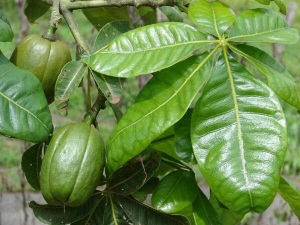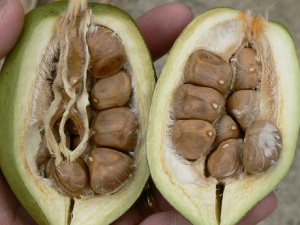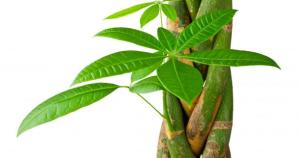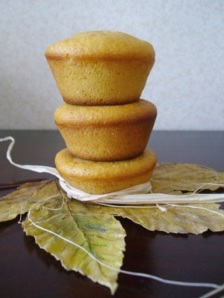 Show me the money or show me the nuts!
Show me the money or show me the nuts!
Have you heard of the Pachira Plant? The Money Tree? Surely, you have heard of one or the other. Actually, they are both the same thing. One is just its fancy name. Either way, it is a great tree that you should definitely know about. Despite its name, the Money Tree does not grow dollars or coins. But instead, a succulent fruit that grows like football shaped large woody pods that can reach 30cm in length. There is confusion between the two related Pachira species, the Malabar Chestnut and the Guiana Chestnut. While the trees are distinctly different in appearance, the scientific names are often used interchangeably. For whatever reason, in the Western U.S. and Hawaii, Pachira Aquatica often refers to the smaller fruiting Malabar Chestnut, while in the Eastern U.S. it refers to the larger fruiting Guiana Chestnut. Let us keep this in mind, and thus avoid much of the confusion.
 Pachira glabra is medium sized tree, reaching from 30-60 feet (9-18 m) tall. The trunk is smooth and greenish gray, and often swollen at the base. The alternate leaves are 6-11 inches (15-28 cm) in length and compound, with 5-9 leaflets. The large and showy flowers are perfect and terminal, with a long peduncle. The petals and numerous stamens are white. The fruit is a smooth, green capsule, 4-8 inches (10-20 cm) in length, and splits opens naturally on longitudinal sutures when ripe. The seeds are rounded but irregular, with about 10-25 per fruit. They are about 1 inch (2.5 cm) in diameter, with a light brown testa.
Pachira glabra is medium sized tree, reaching from 30-60 feet (9-18 m) tall. The trunk is smooth and greenish gray, and often swollen at the base. The alternate leaves are 6-11 inches (15-28 cm) in length and compound, with 5-9 leaflets. The large and showy flowers are perfect and terminal, with a long peduncle. The petals and numerous stamens are white. The fruit is a smooth, green capsule, 4-8 inches (10-20 cm) in length, and splits opens naturally on longitudinal sutures when ripe. The seeds are rounded but irregular, with about 10-25 per fruit. They are about 1 inch (2.5 cm) in diameter, with a light brown testa.
Pachira fruit is a pod whose shape and texture is similar to cacao, and when it is ripe, it turns to reddish-brown, also like cacao, and bursts open to expose large seeds. The seeds which can be eaten raw or roasted. Roasting gives the seeds a chestnut texture and flavor. The seeds can be stored for months in a cool dry place until ready to use. Young leaves and flowers are also edible. Analyses conducted by researchers from the Department of Biochemistry and Molecular Biology at the University of Ceara in Brazil found that Pachira seeds have high amounts of protein (16%) and fat (40 to 50%), and that the essential amino acids tryptophan, threonine and phenylalanine they contain are higher than those found in human milk, chicken egg and cow’s milk. These essential amino acids, which the body obtains from food, promote normal growth in infants and nitrogen and protein balance in adults. However, raw seeds can also be toxic if the embryos are not removed.
 The Money Tree
The Money Tree
The money tree design (bonsai) originated in Taiwan in the 1980s, and was quickly picked up by many other Asian nations. Areas with large Asian populations frequently have money tree plants for sale, because they are supposed to bring good luck and fortune. The money tree plant is particularly associated with China, and is often given out at Chinese New Year complete with red banners and other lucky decorations. A money tree plant with leaves in clusters of seven, another powerful number, is considered to be especially lucky.
Legend has it that a poor farmer in a small valley community in Taiwan discovered a Pachira tree growing in his field one day. He was a hard-working farmer, but his labors yielded minimal returns. He realized that it was an unusual plant. The farmer took the plant home to study it, thinking to himself that perhaps this was the answer to his prayers for prosperity. He quickly learned that the plant required very little attention, being hardy and tolerant of low light and dry conditions. He cultivated several plants from seeds, and took them to the local marketplace. They sold immediately, and people clamored for more. The elated farmer called his prize plant the “good luck money tree” or “good fortune tree,” and this common name resonates worldwide now.
The real story: According to the Aris b.v. nursery website, Taiwanese agricultural engineers first encountered the wild Pachira tree growing in the mountains of Mexico in 1964. Their initial thought was to explore the potential of the Pachira as a fruit tree. They took seeds to Taiwan and planted them in the mountains, but the fruits could not sustain industrial production. The number of trees, though, multiplied dramatically.
You have to try this. Can’t describe it – you gotta make it. 🙂
 Pachira and Chocolate Cream Cupcakes
Pachira and Chocolate Cream Cupcakes
*www.lesenviesdemanu.com*
Ingredients
2 eggs
80 g butter
100 g dark chocolate
80 g caster sugar
30 g flour
Pachira Cream:
200 g butter
1 tablespoon icing sugar
2 tablespoons Pachira Cream
Instructions
Melt chocolate and butter in microwave. Mix eggs and sugar until frothy and stir into the chocolate/butter mixture. Add flour gradually. Half fill the cupcake boxes to the preparation; add a tablespoon Pachira cream and cover with chocolate mixture. Bake for 20 minutes at 200 ° thermostat cool.
Pachira Cream
Beat butter until fluffy, add a tablespoon of icing sugar and stir in Pachira cream, beat again for a few minutes. Place the Pachira in a cream pastry bag and decorate each cupcake.
Ingredients
170g flour T55
80g ground almonds
1 packet yeast
80 g dark brown sugar
1 tbsp Pachira cream
1 tsp vanilla extract
1 egg
120g pumpkin puree
250 ml milk
2 tbsp honey
Instructions
Mix everything and put in a muffin pan, silicone is better. 20 minutes in oven at 180 c. Let it cool before removing from pan. Voilà! Ready to eat!




























These look very yummy! Where would one find pachira? 🙂
have plenty in my frontyard
Mungetho,muranga
You can buy Pachira nuts’s at Spanish grocery stores or Chinese super markets. If you prefer, you can buy it already made on line. But, homemade is much better!
Good to know! I’m going to look for this next time I’m in our regular Spanish market. I had never heard of this before.
Sure! If you find it, let me know. 🙂
Will do!
Pingback: cash Zoom | Business Banking
Hi there, the raw seed is indeed incredibly tasty. I wanted to plant one, when I read on a FAO review that it could be ” containing toxic and possibly carcinogenic cyclopropenic fatty acids” (1985). I also read tht this comment only applied to the red flowers Guyana chestut, not the white flower Malabar.
Any link to the Brazilian study to really clear that out ? Thank you !
Hi everyone, Im looking for recipies on the pachera nuts and to roast them for snack.
How to get the saba seeds? Which place available saba seeds ? I would like to sampling money tree (saba tree) please give the cell number or mail I’d.
thankyouverymuch
IKEA! I just bought one for $7.99. It’s perfect for my RV lifestyle.
Hi
Pingback: Faits et avantages de la châtaigne malabar – bedroomdecor.me
Can pachira tree be grown commercial scale
The recipe for pachira cream calls for, pachira cream. Are there directions for making the pachira cream that goes into the pachira cream?